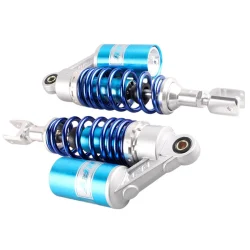Components and concepts related to motorcycle suspension
2023-12-11
A motorcycle suspension system plays a crucial role in ensuring a smooth and controlled ride by managing the interaction between the tires and the road surface. It consists of various components that work together to absorb shocks, maintain tire contact with the road, and provide stability. Here are key components and concepts related to motorcycle suspension:
1. Front Forks:
- The front forks are a pair of telescopic tubes that connect the front wheel to the motorcycle frame.
- They contain a suspension system that includes springs and dampers (shock absorbers).
- Springs provide the primary suspension support, while dampers control the rate of spring movement and prevent oscillations.
2. Rear Suspension:
- The rear suspension system typically includes a shock absorber and a linkage system that connects the swingarm to the motorcycle frame.
- The swingarm holds the rear wheel and moves up and down in response to bumps and road irregularities.
- Like the front forks, the rear shock absorber uses springs and dampers to manage suspension movement.
3. Springs:
- Springs are used in both front and rear suspension systems to absorb shocks and maintain contact between the tires and the road.
- Common types of springs include coil springs and progressive rate springs. Progressive rate springs provide variable resistance based on compression.
4. Dampers (Shock Absorbers):
- Dampers, or shock absorbers, control the movement of the springs by dissipating kinetic energy as heat.
- They prevent the suspension from bouncing excessively after hitting a bump and help maintain tire contact with the road.
- Adjustable dampers allow riders to fine-tune the suspension to their preferences or specific riding conditions.
5. Preload Adjustment:
- Preload adjustment is a feature that allows riders to adjust the initial compression of the springs to accommodate different loads (e.g., rider weight, luggage).
- Proper preload adjustment ensures that the suspension operates in the optimal part of its travel range.
6. Rebound and Compression Adjustment:
- Some high-performance motorcycles come equipped with adjustable rebound and compression damping.
- Rebound damping controls how quickly the suspension extends after compression, while compression damping controls the rate of compression.
- Adjustable settings allow riders to tailor the suspension to specific riding conditions and preferences.
7. Anti-Dive and Anti-Squat Systems:
- Anti-dive systems on the front forks and anti-squat systems on the rear suspension are designed to counteract the effects of braking and acceleration, respectively.
- These systems aim to maintain a stable ride by minimizing pitch and dive during braking and squat during acceleration.
8. Inverted Forks:
- Inverted (or upside-down) forks have the stanchions at the bottom and the sliders at the top. They are often used in high-performance motorcycles for increased strength and reduced unsprung weight.
Proper maintenance and adjustment of the motorcycle suspension system are essential for optimal performance, rider comfort, and safety. Riders may need to experiment with settings to find the right balance for their riding style and preferences. Additionally, regular inspection of suspension components and lubrication is crucial for longevity and safety.



